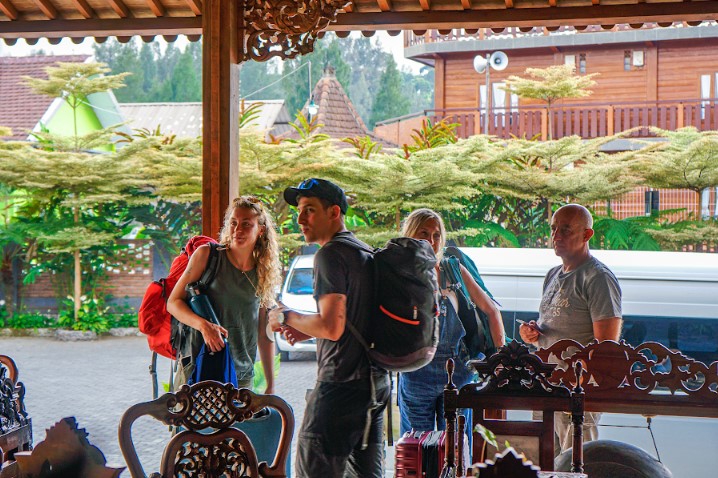And then everything shut down. Except, of course, nature, which flourished.
“The pandemic provided a wake-up call,” said Gregory Miller, executive director of the Center for Responsible Travel, a D.C.-based nonprofit. “We’re not saying don’t travel, but be a responsible traveler. Take a holistic approach to sustainable travel that includes the natural, cultural and spiritual elements of a place.” (Disclaimer: I contributed a chapter to the organization’s book about overtourism.)
A variety of tools can help travelers plan a sustainable vacation, including several that debuted during this health crisis. For example, last October, Google Flights added carbon emission estimates to its searches, as well as recommendations for less polluted routes. In April, Skyscanner’s Greener Choice, which provides a similar service for air travel, expanded to car rentals: Road-trippers can now search for hybrid and electric cars. In November, Booking.com launched a Travel Sustainable badge and filter that highlights eco-friendly lodgings. The same month, Wilderness Scotland and its sister companies in England and Ireland introduced a carbon labeling program that displays an emissions figure beside each adventure tour, similar to calories posted on a menu.
As the world cautiously reopens, here are more tips to assembling a green holiday that would earn the approval of Mother Earth.
When picking a vacation spot, start with the Environmental Performance Index, a Yale and Columbia University research project that ranks 180 countries for their greenness. This year, Denmark took the top spot, followed by the United Kingdom, Finland, Malta and Sweden. The United States came in at No. 43, between Dominica (No. 42) and Namibia (No. 44). The researchers determined that several countries, including the top two placers, are on track to achieve greenhouse gas neutrality by 2050. However, several nations, such as China and India, are moving in the opposite direction, so you might want to wait until they pull a U-turn on the road to sustainability.
Anna Spenceley, a sustainable tourism expert and author, recommends places (and businesses) that organizations accredited by the Global Sustainable Tourism Council have certified. She also directs travelers to destinations that support global environmental agreements, such as the Glasgow Declaration on Climate Action in Tourism, which boasts nearly 540 signatories, and Tourism Declares a Climate Emergency, whose 438 members include the Oregon Coast Visitors Association, Visit Valencia and Tourism Vancouver Island.
Green Destinations, a Tourism Declares supporter, releases the Top 100 Destination Sustainability Stories every year. Recent winners include the return of European bison to Romania’s Vanatori Neamt Nature Park and a marine cleanup on Japan’s Yoron Island. The Dutch organization also runs the Good Travel Guide, a trip-planning resource with such inspiring ideas as Nahuelbuta, the oldest mountain range in Chile, and the Cardamom Tented Camp in Cambodia.
Larry Yu, a professor of hospitality management at George Washington University’s School of Business, mentioned several countries with environmental chops. Among his picks: the Netherlands (“they bike a lot”), Bhutan (“more than 50 percent of land is covered by forest”), Palau (visitors must sign an eco-pledge), Uruguay (most of its electricity comes from renewable sources), Cambodia (“pursuing sustainable development”) and Costa Rica, the valedictorian of eco-tourism.
It is equally important to know when to skip a destination because of cultural sensitivities, vulnerable resources or overtourism. Jared Sternberg, founder of Gondwana Ecotours, scrapped an itinerary to see the polar bears in Kaktovik because of the undue pressure it would place on the tiny Alaskan community, in addition to what he described as the villagers’ “polarized” sentiments toward tourism. “It wasn’t doing any favors to sustainability,” he said by phone from Alaska. Also on his dump-the-bucket list: the Galápagos Islands and Yucatán, Mexico. “It needs a serious break,” he said of the Mexican state that set a record in 2019 with more than 3.2 million visitors.
Finally, remember that vacationing is a state of mind, not a mileage contest. The pandemic taught us that we don’t need to travel far to escape mentally. “Look for options that are a bit closer to home,” said Bradley Cox, communications director at Green Globe, a lodging certification organization based in California. “Domestic businesses might be in need of your patronage and have better availability and choices, particularly midweek. Choosing domestic also helps lower the environmental footprint.”
To dream in green, you don’t need to sever ties with civilization and fall off the grid; hundreds of lodgings are sustainable and swanky, or at least comfy and connected. For a broad sampling, check out the collections on Green Pearls, Kind Traveler, Wayaj and Eco Hotels & Resorts, which specialize in eco-stays around the world.
Whenever possible, choose smaller, independently run accommodations, which will typically generate less waste and cultivate deeper ties with the community. One exemplar: Lapa Rios Lodge in Costa Rica: 17 deluxe bungalows and villas surrounded by more than 1,000 acres of protected rainforest on the Osa Peninsula.
“I would be honored to bring people down here,” Sternberg said of the eco-lodge he discovered during a scouting trip in Costa Rica. “Every building is built by locals. They are solar- and hydro-powered and use a biodigester to produce gas. Pigs eat all the scraps, and what minimal trash is created is recycled or composted. It is luxurious for the right person.”
Of course, sometimes you may need to book a chain hotel. Rest assured: Most of the major hospitality companies have devised sustainable programs, such as Hilton’s Travel with Purpose, IHG Hotels & Resorts’ Green Engage and Marriott International’s Serve360. In addition to recycling and reducing food waste — i.e., the Hotel Kitchen project spearheaded by the American Hotel and Lodging Association (AHLA) and the World Wildlife Fund — hotels are phasing out single-use plastic. First came straws. Next up: elfin bathroom amenities. In 2019, Marriott, Hyatt and IHG properties announced the switch to refillable pump bottles. States have also entered the conversation. California and New York passed laws that will ban the minis starting in 2023 and 2024, respectively.
“America’s hotel brands, owners, operators, employees and guests are working to reduce carbon emissions, lower energy usage, conserve water, source responsibly and minimize waste through innovative and sustainable experiences and events,” said Chip Rogers, president and CEO of the AHLA, adding: “While America’s hotels have made significant strides in the effort to be more sustainable, we also recognize that there is still more to do.”
Be aware that just because a hotel claims to be eco-friendly doesn’t mean it is. Greenwashing is an unfortunate byproduct of the sustainable movement. For reassurance, seek out properties that have received a stamp of approval from a reputable environmental organization, such as the Global Sustainable Tourism Council, EarthCheck, Green Globe or the U.S. Green Building Council (USGBC), which runs the LEED, or Leadership in Energy and Environmental Design, certification program.
“Independent, third-party verification is the only way to assure that a business is adhering to the internationally accepted criteria for sustainable tourism,” said Cox of Green Globe, which counts more than 500 members in 80-plus countries.
The USGBC has certified more than 800 hotels around the world, a diverse group that includes the Bucuti & Tara Beach Resort in Aruba, the Caribbean’s first carbon-neutral hotel; Courtyard Brussels EU, a Marriott property in Belgium; and Proximity Hotel in Greensboro, N.C., the first hotel to acquire the highest Platinum level. In 2018, the organization unveiled LEED Zero, which awards buildings that have achieved net-zero carbon emissions in one of four categories over a 12-month period. The group has handed out about 100 certifications to date.
“When choosing a destination or an accommodation, travelers can compare environmental initiatives, conservation efforts and how much investment and commitment it is putting in to truly deliver a sustainable experience,” said Julia Simpson, president and CEO of the London-based World Travel and Tourism Council, which recently launched Hotel Sustainability Basics, a set of criteria geared toward the hospitality industry.
Choosing a mode of transportation
Sobering news for travelers: Transportation releases a lot of greenhouse gases. According to 2020 data from the Environmental Protection Agency, 27 percent of emissions in the United States stems from cars, trucks, ships, trains, planes and more, the highest percentage of any major industry. Of that total, airlines account for 8 percent of emissions stateside, according to the EPA. Worldwide, the D.C.-based Environmental and Energy Study Institute reported that aviation was responsible for 2.4 percent of total carbon dioxide emissions in 2018 — and it could get worse. “By 2050, commercial aircraft emissions could triple given the projected growth of passenger air travel and freight,” the nonprofit surmised in a recent brief.
Airlines are pointing their noses toward greener horizons. Last October, members of the International Air Travel Association, which includes nearly 300 carriers in some 120 countries, backed the Net Zero Carbon Emission Challenge by 2050. Separately, Delta shared in early 2020 its aspiration of becoming the world’s first carbon-neutral airline, funneling $1 billion dollars into its 10-year goal. JetBlue, the first U.S. airline to voluntarily offset carbon dioxide emissions on all domestic flights, is aiming for 2040, as is Alaska Airlines. United, Southwest and American Airlines are shooting for 2050.
“The airlines are working hard to change,” Yu said. “But they need to find a way to increase production of biofuel.”
Passengers can do their part by making conscientious decisions before and during flights. For example, planes guzzle fuel during takeoff and landing, so book a nonstop flight. Bonus points for choosing a sustainable airport, such as Seattle-Tacoma International or Chicago O’Hare. Support airlines that are ditching single-use plastic, such as Air France and Alaska Airlines, which serve Boxed Water. Contribute to the carrier’s carbon offset program. American Airlines, for instance, has partnered with Cool Effect, which uses the proceeds to fund environmental projects in Mexico, Indonesia and Honduras. Also, reduce your airtime by remaining in one location for a longer period.
“We got drunk on these amazingly cheap flights,” said Paul Easto, CEO and founder of Wilderness Scotland. “You can fly less, but you don’t have to necessarily holiday less.”
If you have the vacation days, consider snail rail, the gentler option. According to the Amtrak Connects Us report from May 2021: “Travel on Amtrak trains outside the [Northeast Corridor] emits up to 55{32bc5e747b31d501df756e0d52c4fc33c2ecc33869222042bcd2be76582ed298} fewer [greenhouse gases] than driving alone, and up to 30{32bc5e747b31d501df756e0d52c4fc33c2ecc33869222042bcd2be76582ed298} fewer than flying.” As part of its long-term strategy, the railway hopes to add nearly 40 new routes in the coming years. More immediately, trains are crossing the northern border again, more than two years after Amtrak suspended international trips. Last month, service resumed between New York City and Toronto; trains from Seattle to Vancouver are slated to return in September.
On the other side of the Atlantic, the Trans-European Transport Network will shorten travel times between European Union cities, in addition to electrifying the entire rail system by 2030. Overnight train travel is also getting a chic makeover: Midnight, a “hotel on rails” with private cabins and a restaurant, will launch in 2024 from its Paris hub. Its elevator pitch: “A combination of modern sustainability and glorious Roaring [’20s] charm.”
Cruise ships are often cited as environmental disasters. Friends of the Earth doesn’t mince words: “Cruise ships are a catastrophe for the environment. … They dump toxic waste into our waters, fill the planet with carbon dioxide, and kill marine wildlife.” The cruise lines have been trying to turn over a green leaf, communally and individually. The Cruise Lines International Association’s 2021 Environmental Technologies and Practices Report defines its goals and achievements, such as expanding the number of ships powered by liquefied natural gas, a cleaner alternative fuel.
When choosing a cruise, research the company’s sustainability doctrine, such as Norwegian Cruise Line’s Sail & Sustain and Virgin Voyages’ Epic Sea Change for All. The latter cruise line, which was founded by English ocean conservationist Richard Branson, has eliminated the traditional Henry VIII-style buffet, to reduce food waste; banned unnecessary single-use plastic, such as condiment packets and to-go cups; and incorporated such energy-efficient designs as tinted windows, LED lighting and room sensors, among other eco-friendly measures.
In the Galápagos Islands and Antarctica, cruise ships must abide by governmental laws geared toward protecting the fragile landscape and wildlife. To lessen your effects, seek out smaller vessels affiliated with environmental stalwarts, such as the World Wildlife Fund or National Geographic. In addition, avoid itineraries that visit ports overwhelmed by cruisers, such as Venice, which recently passed a law forbidding large vessels from entering its historic center. To control crowds, the Italian city will start requiring visitors to make a reservation and pay an entrance fee in mid-January.
For road trips, rent a car with good gas mileage — 30 miles per gallon or more — or slide behind the wheel of an electric or hybrid vehicle. Last year, Hertz started offering Teslas in North America. Turo, a peer-to-peer site, has a range of EVs; European rental agencies also have large inventories of plug-in models. Cars are more efficient on highways than stop-and-go streets, so once you are settled into your urban destination, consider parking your ride or returning it.
Of course, human-powered transportation — walking, cycling, paddling — is the greenest form of travel. Take advantage of bike-share programs or hotel loaner bikes. To cover greater distances, hop on an electric bike or scooter. Just be sure to learn the phrase, “On your left,” in the host country’s tongue.
For excursions, the type of tour you choose is as critical as the mode of transportation.
“Sustainability is not only about the environment,” said Heather Kelly, director of research and sustainability for the Adventure Travel Trade Association, whose members strive to adhere to sustainable practices. “We need to maintain economically viable jobs for local people and keep them included in decisions, particularly Indigenous communities and underrepresented groups like women and youth.”
Most cities have tip-based walking tours led by locals, such as Free Tours by Foot, which is offered in cities throughout North America, Europe, Asia, Australia and the Middle East. Free services such as the International Greeter Association pairs residents with visitors in popular tourist destinations (Berlin, Montreal) as well as surprising spots (Iringa, Tanzania; Nis, Serbia). After a short hiatus, Airbnb Experiences is back. Visitors can sign up for such personal excursions as a pasta-making class taught by a Roman family or a graffiti art tour that includes a mango ice cream stop at the Colombian guide’s grandmother’s house in Medellín.
For additional green outing ideas and tour companies, check with the city, state or country’s tourism office, which often has materials dedicated to eco-tourism. Native American and Indigenous tour operators and organizations, such as the Indigenous Tourism Association of Canada and Go Native America, provide an intimate look at their art, culture and traditions within the framework of the natural world.
The locavore movement has gone global, with more restaurants basing their menus on the seasons and harvests of nearby farms. For North American dining, Yu, the hospitality professor at George Washington, recommends the Green Restaurant Association, which has certified restaurants in 47 U.S. states and Canada. HappyCow and Thrillist (the veg city editions) cater to plant-centric diners. If you are craving something from Neptune’s kitchen, Surfrider Foundation’s Ocean Friendly Restaurants gives the thumbs-up to 750 dining spots around the country. The nonprofit’s European chapters boast more than 80 restaurants.
In 2020, the venerable Michelin Guide launched Michelin Green Star. About 375 restaurants in the United States and Europe have earned the eco-accolade. The universe of sustainable culinary stars is expanding.
Potential travelers should take local and national public health directives regarding the pandemic into consideration before planning any trips. Travel health notice information can be found on the Centers for Disease Control and Prevention’s interactive map showing travel recommendations by destination and the CDC’s travel health notice webpage.






More Stories
Cruises from Fremantle: A Gateway to Memorable Journeys
Camping Axes: The Essential Tool for Outdoor Adventures
Why Poland Should Be Your Next Winter Destination: A Guide to Unforgettable Winter Escapes